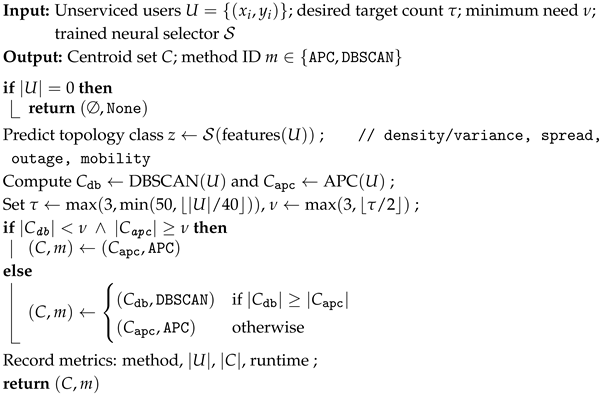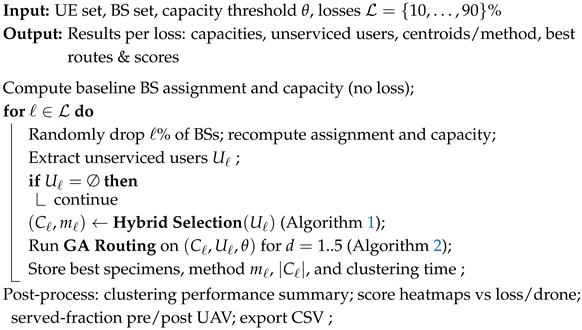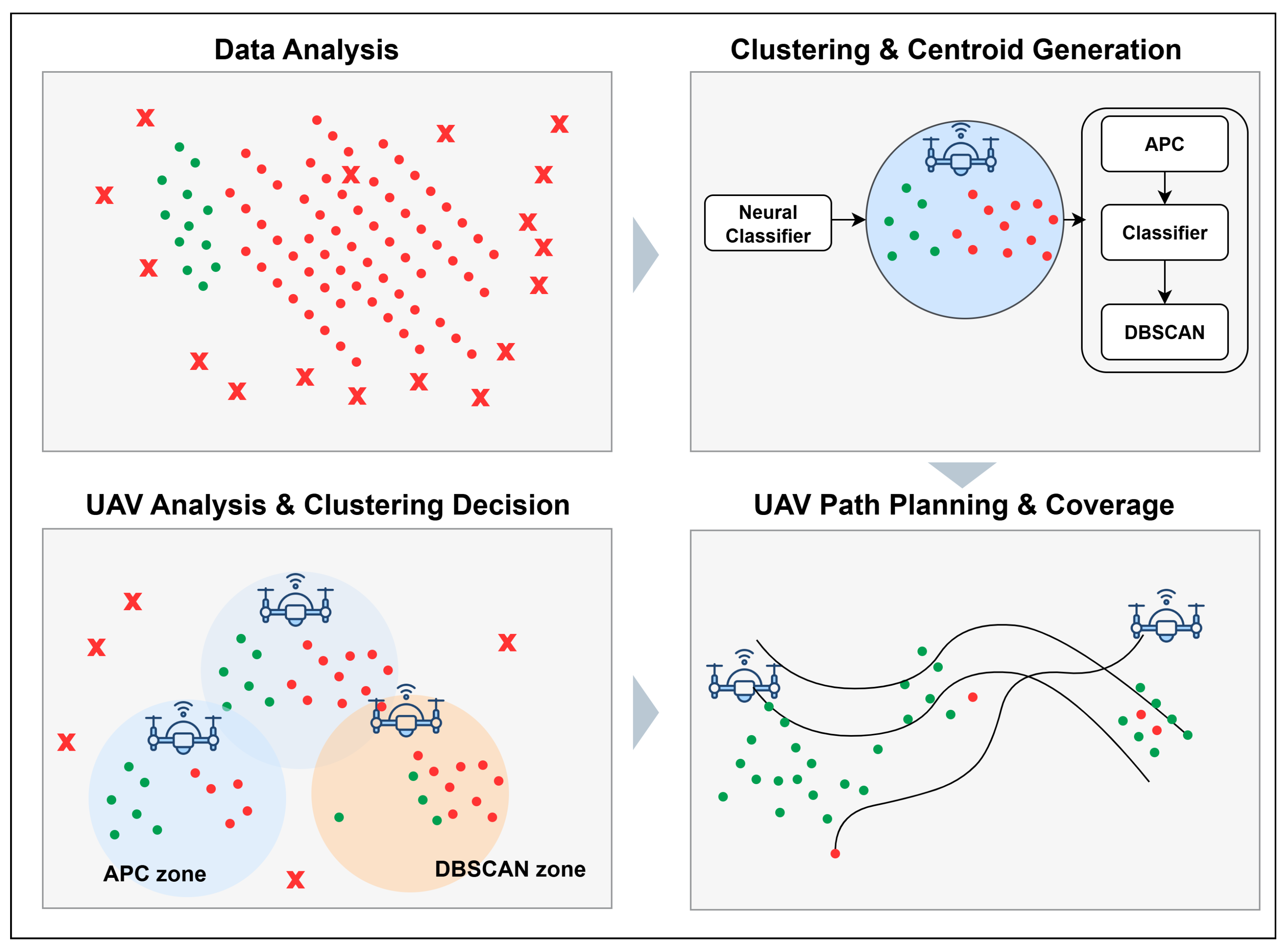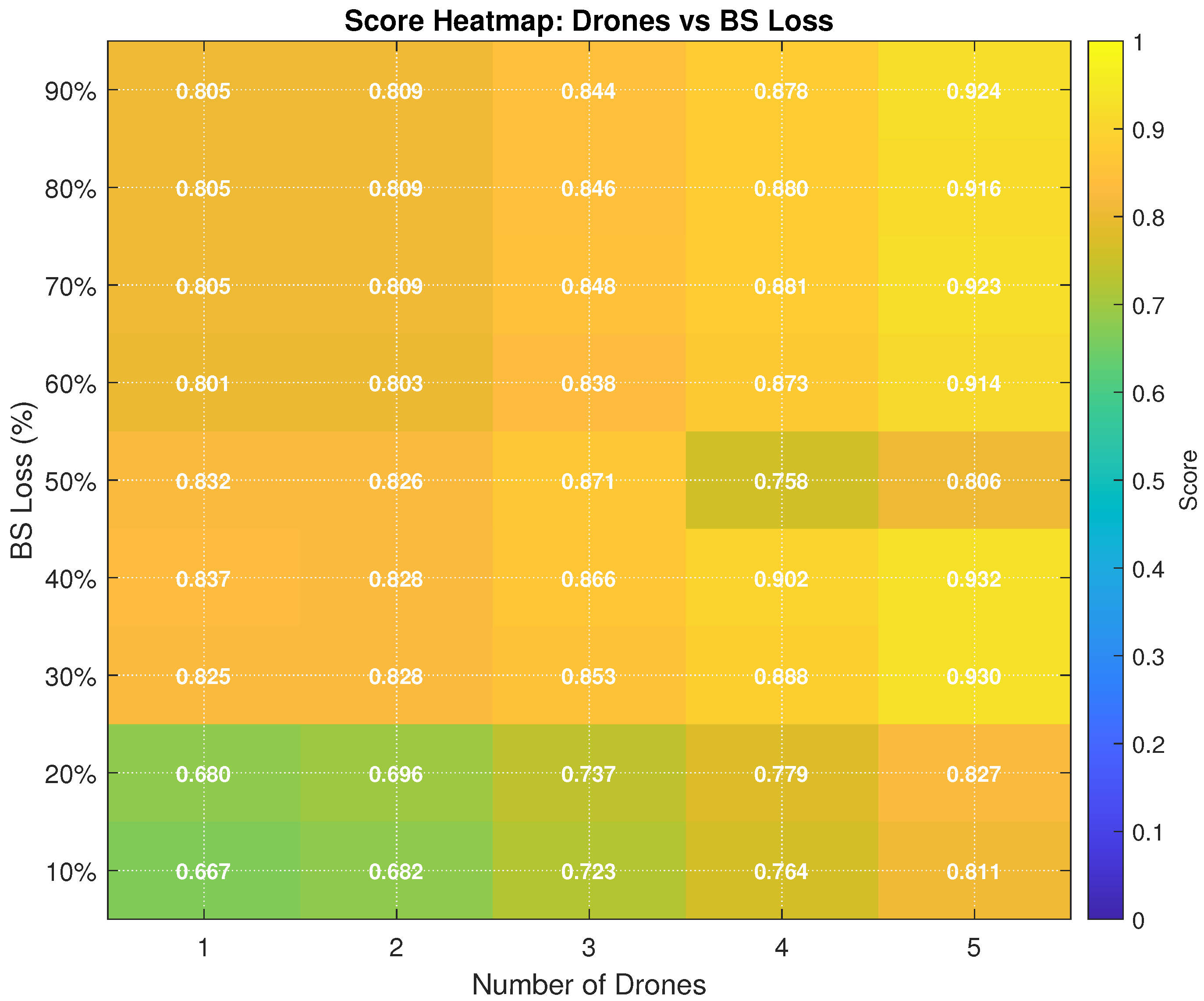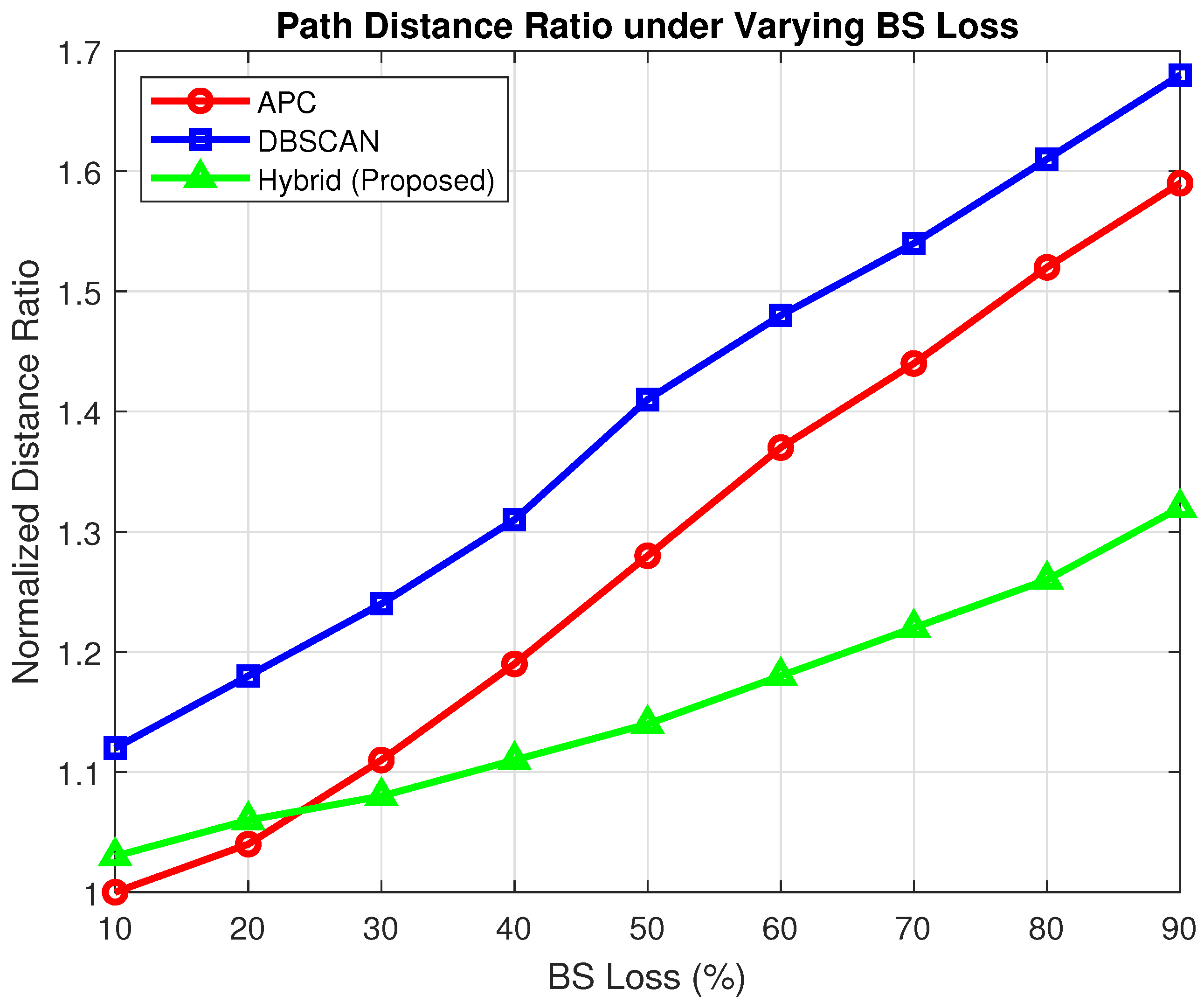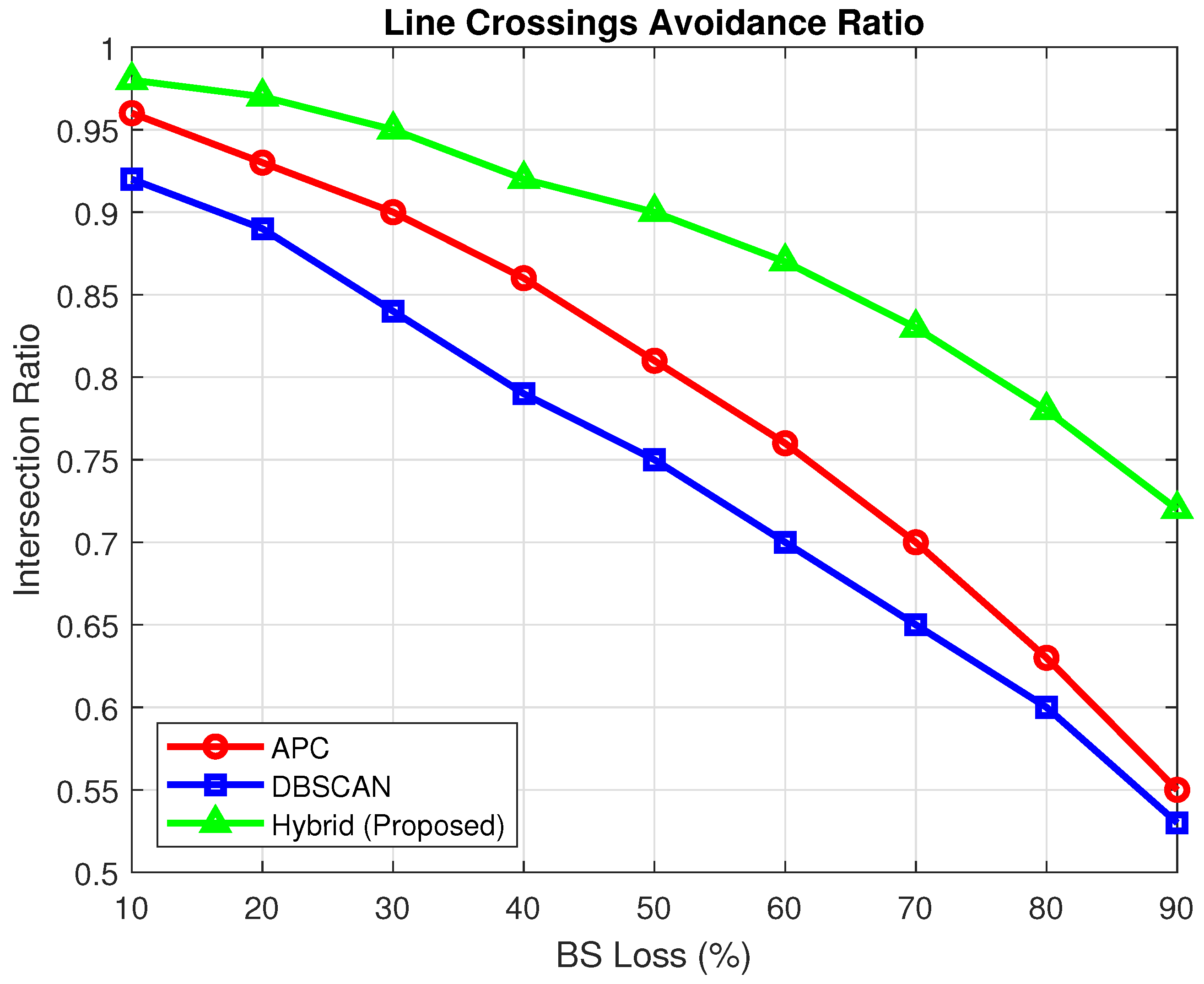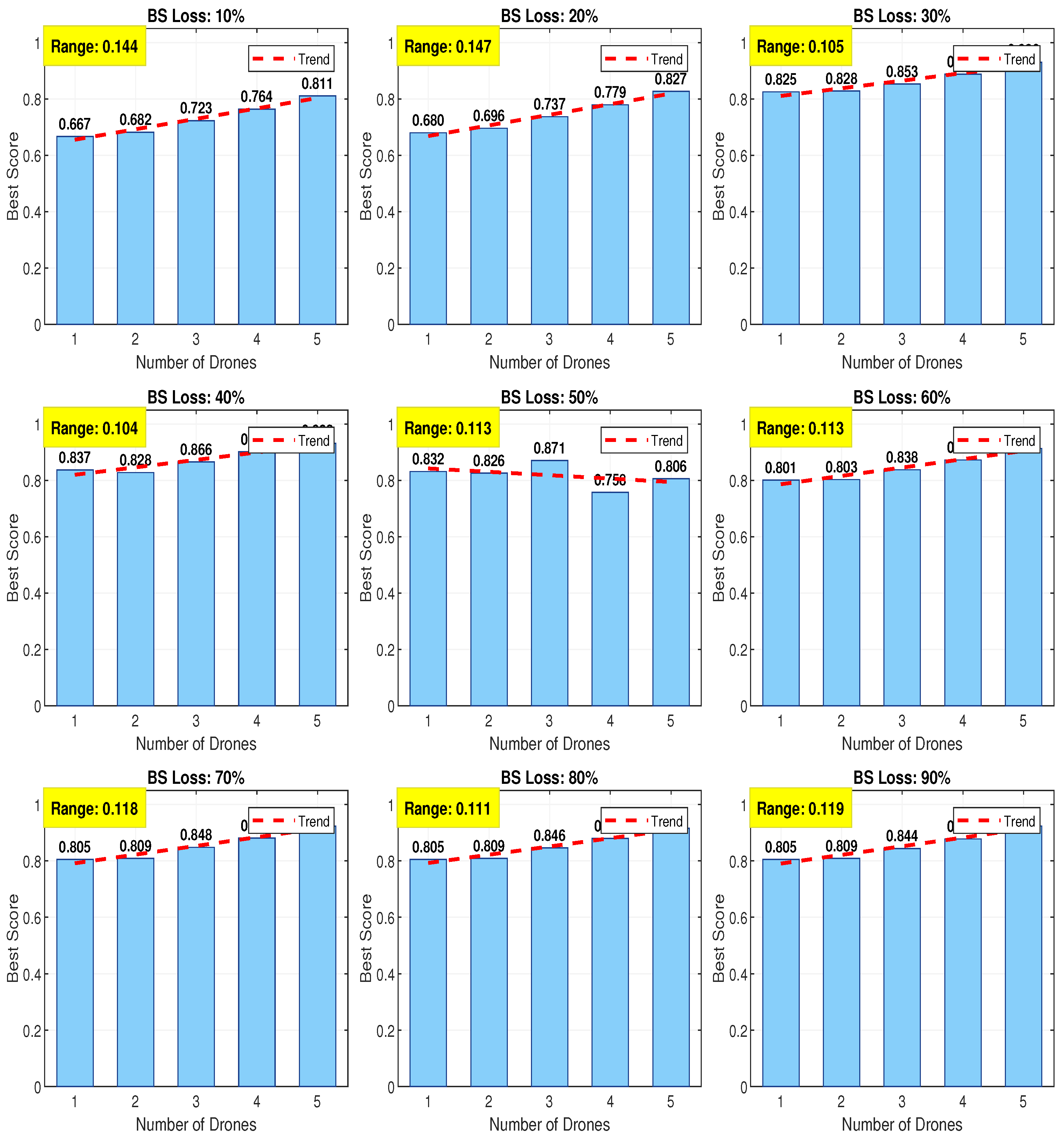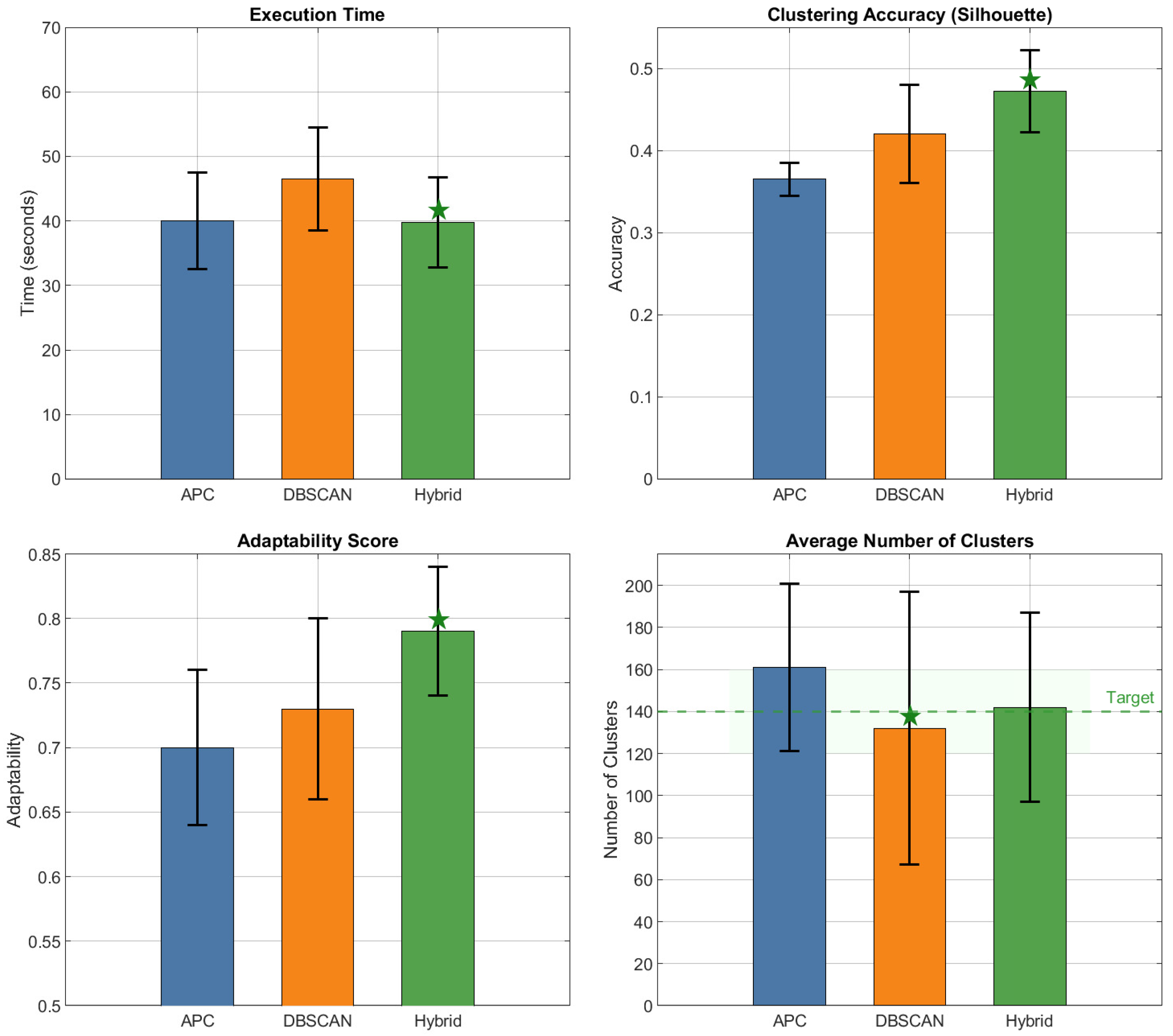2. Related Works
This section offers a comprehensive review, as the proposed framework encompasses multiple research domains: clustering algorithms for UAV-assisted communications, neural-guided dynamic clustering, and multi-objective UAV path optimization. The discussion is provided to ensure the context is provided for readers from diverse backgrounds related to the paper’s scope, including wireless communications, artificial intelligence, and disaster management. Concurrently, the review underscores the specific limitations of existing approaches, which directly inform the proposed hybrid APC–DBSCAN + ANN model. For readers primarily interested in the contribution, summary tables are provided to consolidate the most pertinent insights and facilitate quick comparison without necessitating a full reading of each algorithm description.
RQ1: What clustering algorithms have been used in UAV-assisted wireless coverage, and how do they perform in disaster scenarios?
Clustering algorithms are vital for optimizing UAV-assisted wireless coverage, particularly in disaster scenarios. Among these, K-means and K-means++ have been widely adopted for clustering ground users and UAV deployment. K-means++ enhances the initial centroid selection, significantly improving the user throughput and satisfaction ratio [
6,
7,
8]. The hybrid K-means approach Particle Swarm Optimization (PSO) combines K-means with PSO, achieving a more balanced performance in terms of coverage, energy efficiency, and reliability [
9]. PSO is another widely used technique for optimizing cluster coverage and 3D UAV placement problems. It exhibits faster convergence and requires fewer UAVs than K-means [
4,
10]. The Ellipse Clustering Algorithm further contributes by adjusting the UAV antenna parameters to maximize the user coverage probability while minimizing the transmission power [
11]. Fuzzy Logic and Fuzzy C-Means (FCM) offer dynamic solutions such as cluster head selection based on sensor node energy and storage levels [
7]. An enhanced version, Fitness-based Fuzzy C-Means (Fit-FCM), integrates additional factors such as energy, distance, and trust to improve cluster head selection in UAV-based wireless sensor networks [
12]. DBSCAN, a density-based clustering algorithm, has been used in conjunction with convex optimization for UAV trajectory planning and charger allocation. This integration reduces the number of chargers required while boosting the overall throughput [
13]. Meanwhile, Log Linear Learning has proven effective for UAV deployment in disaster-stricken regions by using a UAV coverage utility function to ensure comprehensive network coverage [
14]. These algorithms have different strengths and weaknesses in disaster scenarios. K-means is effective for initial coverage and user satisfaction, although its performance can vary based on the centroid initialization and distance metrics used [
6,
8]. It supports user association, optimal UAV placement, and altitude selection to maximize data rates in emergencies [
15]. PSO-based algorithms not only reduce the number of UAVs required, but also outperform GA and artificial bee colony (ABC) methods in terms of execution time and energy efficiency [
4,
16]. Fuzzy logic and fit fuzzy c-means clustering improve the lifetime of the network and reduce packet loss, which are crucial for reliable communication in WSNs assisted by UAVs [
7,
12].
DBSCAN minimizes charger use and increases throughput, offering a cost-effective disaster response solution [
13]. Finally, log-linear learning has demonstrated both generality and the best performance compared with optimal selection algorithms in emergency deployments [
14].
Clustering algorithms, such as K-means, PSO, fuzzy logic, FCM, DBSCAN, and log-linear learning, are critical for enhancing the effectiveness of UAV-assisted wireless coverage. These methods contribute significantly to improving coverage, energy efficiency, and system reliability, particularly when the terrestrial communication infrastructure is compromised by the environment. While K-means and PSO offer robust overall performance, algorithms such as Fuzzy Logic and DBSCAN provide specialized advantages in terms of energy conservation and operational cost, making them indispensable in emergency and disaster response scenarios.
Table 1 compares eight clustering methods, K-means, K-means++, PSO, FCM, DBSCAN, and log-linear learning, used in UAV-assisted disaster scenarios. It highlights each method’s type, disaster support capability, optimization goals, and respective strengths and limitations. For instance, K-means++ offers simplicity and fast convergence but is sensitive to centroid initialization, whereas DBSCAN is cost-effective in sparse networks but struggles with scalability. This comparison sets the foundation for why a hybrid adaptive clustering method is needed in post-disaster UAV networks (see
Table 1).
Recent studies have investigated alternatives beyond traditional clustering methods. Fuzzy C-means and its variants have been shown to enhance adaptability and energy efficiency in UAV-assisted networks [
3,
7,
12], while swarm-intelligence techniques, such as PSO-based clustering, have demonstrated the ability to optimize the required number of needed UAV and convergence time [
4]. More recently, the introduction of clustering and pairing in NOMA-aided UAV systems has aimed to improve spectral efficiency and fairness [
5]. Although these approaches are promising, they are generally tailored for energy optimization or spectral-domain efficiency under relatively stable conditions. In contrast, the APC–DBSCAN combination specifically addresses the dual challenges of sparse, noisy distributions and dense, structured clusters that are characteristic of post-disaster environments.
RQ2: How have machine-learning or neural models been used to guide clustering or adapt path planning in dynamic environments?
Machine-learning and neural models have been increasingly applied to guide clustering and adapt path planning in dynamic environments. One notable approach is the Two-Stage Learning-Based Model, where the first stage extracts features of the surrounding environment and predicts the trajectories of dynamic obstacles, and the second stage utilizes reinforcement learning to plan a feasible and efficient path based on those predictions. This model demonstrates high predictability and processing capacity for dynamic obstacles and successfully executes planning tasks in various dynamic scenarios [
17]. In the realm of Neural Network-Guided Path Planning, methods such as Neural Sampling Technique (NST), Probabilistic Roadmaps (PRM), and Rapidly Exploring Random Trees (RRT) employ neural networks trained on datasets generated through PRM and RRT. These techniques notably reduce the dataset generation time and enhance path-planning efficiency in environments with numerous obstacles [
18]. A Graph Neural Network (GNN)-Based Planner, further improves planning by leveraging prior exploration experience and minimizing replanning costs under unpredictable conditions. This results in a high planning performance with fast speeds and low path costs, outperforming both traditional and other learning-based methods [
19]. Another advancement is the Dynamic Distance Transform Algorithm, in which a neural model adapts the distance transform method for dynamic contexts, forming a dynamically updating potential field. This ensures an effective local adaptation and optimal path planning in dynamic environments [
20].
In terms of Clustering for Path Planning, cluster-based routing for UAVs integrates online path planning, clustering-based network topology, reinforcement-learning-driven cluster management, and data routing. The outcomes include improved coverage, better adaptation to changing environments, enhanced packet delivery ratios, and reduced communication delays [
21]. Furthermore, combining clustering and neural networks for trajectory prediction, such as the use of DBSCAN and multicell neural networks (MCNN), produces accurate short-term 4D trajectory predictions, demonstrating their robustness and effectiveness in dynamic settings [
22,
23].
Among Hybrid and Reinforcement Learning Approaches, Q-Learning-Based Local Planning considers factors such as path length, safety, and energy consumption and shows reliable performance in both static and dynamic environments by avoiding the typical pitfalls of conventional algorithms [
24]. When ANNs are combined with Q-learning, the ANN serves as a path-planning controller, whereas Q-learning generates training samples. This hybrid strategy is more effective than using either technique alone to find optimal paths [
25]. In practical applications, Multi-Robot Systems (MRS) benefit from improved neural dynamics approaches that incorporate territorial mechanisms, resulting in robust and fair path planning in complex and changing environments [
26]. Similarly, Autonomous Vehicles leverage deep reinforcement learning and clustering-based strategies to develop both theoretical models and practical solutions for effectively navigating dynamic surroundings [
27,
28].
The integration of machine learning and neural models has significantly improved path planning and clustering performance in dynamic environments. By enhancing efficiency, adaptability, and accuracy, these methods, particularly those involving reinforcement learning, neural networks, and clustering, effectively address challenges posed by dynamic obstacles and varying conditions.
Table 2 summarizes representative machine learning (ML)- and ANN-based frameworks applied to UAV operations in dynamic environments. Although many of these approaches, such as two-stage ML + reinforcement learning (RL) models, GNNs, neural potential fields, and hybrid RL routing systems, were originally designed for path planning and navigation, they also demonstrate how learning-based methods improve clustering and user grouping under uncertain conditions. In particular, their adaptability to environmental changes highlights the importance of dynamic, data-driven clustering for UAV-assisted communications. However, existing approaches often emphasize navigation efficiency rather than robust user grouping, leaving a gap when users are mobile, unevenly distributed, or experience fluctuating link qualities. This gap directly motivates our integration of ANN-guided clustering into an adaptive hybrid framework tailored to UAV-based user grouping.
As such, a central challenge in UAV-assisted communication recovery remains insufficiently addressed: the dynamic grouping of users in highly variable environments. Static clustering methods cannot cope with high user mobility, uneven user distributions, and rapidly changing channel conditions, leading to degraded communication efficiency. This gap provides the motivation for this paper, where we introduce an adaptive hybrid clustering framework is guided by artificial neural networks. By combining the adaptability of learning-based clustering with the robustness of hybrid schemes, our approach ensures efficient UAV-based user grouping in dynamic environments.
Recent advances have further extended adaptive clustering into industrial IoT and NOMA-UAV domains. For instance, Smart Collaborative Evolvement for Virtual Group Creation in Customized Industrial IoT introduces probabilistic virtual grouping to adapt to heterogeneous Industrial Internet of Things (IIoT) demands dynamically, improving flexibility in industrial environments [
29,
30,
31]. Similarly, Adaptive Virtual Clustering Methods for Dynamic IoT Edge propose strategies that reconfigure cluster membership in response to load and node heterogeneity [
5,
32,
33]. On the UAV–communication front, Enhanced User Clustering and Pairing Scheme for NOMA-Aided UAV Networks presents an Advanced Balanced K-Means (ABKM) method to ensure fairness and throughput optimization in NOMA settings [
34,
35]. Other works combine path planning and NOMA resource allocation via Deep Reinforcement Learning (DRL) [
36] or explore energy-efficient NOMA-UAV downlink schemes [
37]. These contributions enrich the landscape of adaptive clustering, but differ from our approach: while they focus primarily on spectral efficiency enhancements or domain-specific constraints, our framework targets post-disaster UAV-assisted networks, combining ANN-guided hybrid clustering (APC–DBSCAN) with GA-based trajectory planning to balance coverage, robustness, and multi-objective optimization.
RQ3: What hybrid clustering or dynamic strategy selection methods exist, and how do they affect trajectory or resource efficiency?
Hybrid clustering and dynamic strategy selection methods have been introduced to enhance trajectory planning and resource efficiency in various applications. One of such approach is the Hybrid Selection Multi-Objective Evolutionary Algorithm (HSMEA), which combines angle and distance metrics for clustering individuals, followed by a hybrid selection mechanism. This method strikes an effective balance between convergence and diversity, making it suitable for complex multi-objective optimization tasks [
38]. Another notable method, the Density-based K-means (DKGK) approach, utilizes Differential Evolution (DE) to promote diversification, K-means for refinement, and a GA enhanced with heuristic crossover to ensure fast convergence. This combination outperforms conventional approaches, such as DE, GA, DE-K-means, and GA-K-means, by significantly reducing intra-cluster distances, leading to better clustering accuracy and efficiency [
39].
The hybrid grasshopper and differential evolution-based optimization algorithm (HGDEOA) integrates adaptive strategies into DE, thereby enhancing its global search ability and reducing the risk of premature convergence. This results in improved energy stability, higher throughput, and extended network lifetime in Wireless Sensor Networks (WSNs) [
40]. Similarly, the Hybrid Deep Fixed K-Means (HDF-KMeans) approach merges Deep K-Means++ for advanced feature extraction and centroid initialization with Fixed Centered K-Means to improve stability. This hybrid model enhances clustering accuracy and consistency, particularly in critical domains such as healthcare [
41].
Among the Dynamic Strategy Selection Methods, the Dynamic Genetic Algorithm (DGA) improves the automatic calculation of the number of clusters (k) and improves the population initialization, genetic operators, and fitness functions. These improvements lead to more accurate clustering outcomes and better estimation of the cluster numbers [
42]. The Gaussian Mutation Adaptive Artificial Fish Swarm Algorithm (GAAFSA) incorporates Gaussian mutation and adaptive strategies to avoid local optima and early convergence, which boosts the network lifespan, increases packet reception rates, and reduces packet loss in Industrial Wireless Sensor Networks (IWSNs) [
43]. Meanwhile, adaptive density peak clustering with Fisher linear discriminant (ADPC-FLD) employs kernel density estimation and weighted Euclidean distances, along with adaptive strategies for selecting cluster centers. This significantly enhances the clustering accuracy and efficiency, particularly in high-dimensional data scenarios [
44].
Regarding the effects on trajectory and resource efficiency, methods such as HGDEOA and GAAFSA contribute significantly to energy efficiency and network longevity by optimising cluster head selection and data transmission in WSNs and IWSNs [
40,
43]. In terms of convergence and diversity, HSMEA and DKGK provide robust clustering solutions that enhance system performance [
38,
39]. For applications demanding high precision, such as healthcare and complex data analysis, techniques such as HDF-KMeans and ADPC-FLD deliver notable improvements in precision and consistency [
41,
44]. Hybrid clustering and dynamic strategy selection methods offer meaningful advancements in trajectory optimization and resource efficiency. By enhancing energy stability, promoting balanced convergence and diversity, and increasing clustering accuracy, these techniques are valuable in a wide array of technical domains.
Table 3 compares hybrid approaches, such as HSMEA, DKGK, HGDEOA, and adaptive clustering methods. Each combines different algorithms (e.g., DE+GA+K-means) to optimize clustering accuracy, convergence, and resource use. The strengths of these models include improved energy stability and accuracy; however, their limitations often involve parameter tuning or domain-specific constraints. The discussion in this paper leverages this to justify the hybrid APC–DBSCAN + ANN framework (see
Table 3).
RQ4: What fitness functions or multi-objective optimization approaches are most effective for UAV path planning in DRNs?
To identify the most effective fitness functions or multi-objective optimization approaches for UAV path planning in DRNs, various insights have emerged from recent research. Several fitness functions are typically used in this context. One core focus is on minimizing both distance and risk, as seen in methods that apply the Bézier theory and impose constraints such as turning angle and flight altitude [
45]. Similarly, another study incorporated traveling distance and risk along with height, angle, and slope limitations to guide UAV navigation [
46].
Energy efficiency is another critical criterion. Some models aim to reduce fuel consumption, altitude costs, and threat exposure during flights [
47]. In particular, Bézier curve-guided paths optimized via GAs and multi-objective swarm-based strategies are effective in improving energy use [
48]. In multi-UAV systems, utility-based objectives such as maximizing the number of people rescued are coupled with collision avoidance to ensure operational safety [
49]. Additionally, Quality of Service (QoS) is emphasized in UAV-assisted Mobile Edge Computing (MEC) frameworks, where path planning considers geometric distance, risk level, and terminal user demand [
50]. Several techniques have been proposed for multi-objective approaches. A knee-guided differential evolution algorithm directs the search toward optimal UAV paths with smooth trajectory generation [
45], whereas another variant incorporates an adaptive selection mutation to improve refinement while preserving exploration [
46]. RL methods are effective in dynamic urban settings, optimizing UAV paths under conditions of mobile obstacles and variable threats [
50].
GAs remain widely used for path optimization due to their versatility in complex optimization. One approach normalizes the fitness criteria and employs swarm-based enhancements for energy efficiency [
48]. Another study combined an adaptive GA for mission assignment with an improved artificial bee colony method for optimal path planning [
51]. The Hybrid Equilibrium Optimizer (HEO) uses techniques such as Gaussian distribution estimation and Lévy flight to divide populations and balance exploration and exploitation [
47]. Moreover, Ant Colony Optimization (ACO) has been improved for accurate 3D path planning, minimizing flight path length, and terrain threats [
52].
Table 4 outlines the fitness criteria, such as distance, risk, energy, and QoS, alongside the optimization technique used (e.g., DE, RL, GA, hybrid metaheuristics, ACO). This emphasizes that effective UAV path planning must balance efficiency, safety, and adaptability. This reinforces why the proposed GA-based framework incorporates multiple weighted objectives (see
Table 4).
Effective UAV path planning in DRNs using GA depends on fitness functions that measure distance, risk, energy consumption, and mission utility. Multi-objective optimization techniques, such as differential evolution, reinforcement learning, GAs, hybrid optimization, and ant colony optimization, exhibit strong capabilities in navigating complex dynamic environments. Each technique offers unique strengths, ranging from convergence speed to adaptability, making it appropriate for different operational requirements. Expanding
Table 4 and
Table 5 details the scope, strengths, and limitations of specific optimization approaches, such as knee-guided DE, RL-based planning, GA+swarm hybrids, and enhanced ACO. It shows how each method addresses constraints such as smoothness, collision avoidance, and threat minimization, further supporting the design choices in the hybrid framework (see
Table 5).
RQ5: How do clustering and optimization approaches handle varying BS loss, user densities, or terrain constraints in DRNs?
Clustering and Optimization Approaches in DRNs
To handle varying BS losses, clustering approaches often face challenges due to interference from nodes outside the cluster. To address this, some frameworks allow clusters to exchange optimization parameters through low-rate backhauls, approaching near-global optimization performance [
53]. In the case of BS failures, delay-tolerant networks (DTNs) offer resilience by enabling user devices to self-organize and relay messages through multihop connections to functional BSs or nearby users, thereby improving load balancing [
54]. Under sparse BS deployment, users may rely on others who are willing to relay messages to an accessible BS. Optimized beaconing policies are used to maximize message delivery success while minimizing power usage [
55]. In high-density scenarios, clustering algorithms such as K-means, DBSCAN, and Agglomerative Clustering were evaluated to determine the most efficient choice. ML methods can also predict optimal BS parameters, thereby reducing the computational overhead [
56].
The optimization of irregular terrain requires sophisticated modeling. For instance, the Longley-Rice model enables accurate path-loss estimation using high-resolution topographic data [
57]. In urban vehicular DTNs, geographic complexity is managed by segmenting maps into adjacent regions to aid delay analysis and trajectory prediction [
58]. Energy-saving strategies include optimizing the activation and deactivation of BS transmissions. Clustering and timed activation approaches help minimize energy use while fulfilling traffic demands [
59]. Battery-aware techniques, such as Improved Lifetime Optimization Clustering (ILCK), apply Kruskal’s minimal spanning tree heuristic and monitor battery health to extend the network lifetime [
60]. Analytical methods, such as convex optimization, are used to minimize the total transmit power under QoS constraints and are often extended to multi-BS scenarios using iterative algorithms [
61]. Metaheuristic approaches, such as chaotic gorilla troop optimization, enhance energy-aware clustering by considering the neighbor distance, BS proximity, and energy ratio [
62].
Table 6 summarizes the strategies for dealing with BS loss, varying user densities, and terrain constraints. Approaches range from DTN routing and ML-based parameter tuning to terrain-aware propagation models and energy-saving BS scheduling. The relevance of the proposed work lies in showing how adaptability to these challenges is crucial (see
Table 6).
These clustering and optimization techniques collectively address the challenges related to BS loss, varying user densities, and complex terrain in disaster relief networks. By leveraging analytical models, adaptive routing, and energy-aware clustering, these methods can significantly improve the reliability and efficiency of DRNs. The strategies compared in
Table 7 further illustrate how clustering and optimization methods address BS loss, varying user densities, and terrain constraints in DRNs. By juxtaposing their benefits and limitations, the table highlights that adaptability and energy-awareness are the most critical enablers for post-disaster UAV deployments.
To provide a broader perspective,
Table 8 consolidates the methods examined across all five research questions (RQ1–RQ5). This summary highlights how clustering, learning-based optimization, and hybrid strategies collectively contribute to improving UAV service coverage, path efficiency, and resilience in disaster response networks.
3. Environment Modeling
This section outlines the key assumptions and system architecture of the studied UAV-assisted emergency network deployment in post-disaster scenarios. The objective is to provide resilient and rapid connectivity to UEs through the deployment of MABSs using a newly proposed hybrid clustering-based optimization framework. The proposed solution enhances the previous work [
63] by dynamically selecting between APC and a learned clustering strategy that combines DBSCAN with an ANN. This hybrid model enables more flexible and adaptive UAV path planning depending on the network density, terrain, and disaster impact levels.
Figure 1 illustrates the proposed system model, which offers an intelligent and resilient solution for restoring wireless connectivity in post-disaster environments in which conventional base stations have failed. UAVs are used as MABSs to provide temporary coverage to disconnected UEs. The green markers indicate UEs with active services, whereas the red markers indicate UEs that have lost connectivity and require temporary MABS coverage. Each MABS follows an optimized trajectory to visit the centroid of the user clusters.
The process begins with the identification of failed base station zones and the classification of the UEs as either connected or disconnected. Spatial features, such as the density of the UE, the levels of outage at the base station and the spread of the distribution, are then extracted and fed into a lightweight neural classifier. This classifier dynamically selects the optimal clustering method by choosing either APC for dense, structured regions or DBSCAN with ANN-guided parameter tuning for sparse or irregular topologies. This hybrid selection process enables more accurate and adaptive clustering, thereby ensuring efficient centroid placement. These centroids serve as UAV visitation points and are further processed by a GA that optimizes the UAV trajectories based on multi-objective criteria, including service ratio, smoothness, and intersection avoidance.
The hybrid model’s ability to adapt to varying UE distributions and disaster intensities, combined with machine-learning-driven decision-making, makes it a robust and scalable framework for real-time UAV-assisted communication restoration. The adaptability of the system was further enhanced by incorporating real-time data updates, allowing for dynamic reclustering and trajectory adjustments as the post-disaster scenario evolved. This continuous optimization ensures that the UAV network remains responsive to changing ground conditions, such as shifting UE concentrations or newly restored BSs.
In this extended model, the cluster centroids were computed using a decision layer selected between APC and DBSCAN+ANN, depending on the real-time conditions. Moreover, the framework includes a predictive component that anticipates potential changes in the UE distribution based on historical patterns and current movement trends, enabling proactive UAV positioning for improved service continuity.
The neural selector evaluates the features of spatial distribution, such as variance in the density of the user and clustering coefficients, and dynamically decides whether APC or DBSCAN should be used. This mechanism ensures adaptability by preventing rigid application of a single clustering method, which may fail under dynamic conditions.
Figure 1 presents the hybrid architecture decision pipeline, where each stage is annotated with its operational objective.
3.1. Clustering Mode Selection
The novel contribution of this study is the dynamic selection of a clustering method for identifying UAV visitation centroids. This logic is defined as shown in
Table 9.
The ANN model was pretrained on synthetic post-disaster UE distributions to predict the optimal clustering configurations. When used with DBSCAN, the ANN adjusts the clustering parameters (e.g., and MinPts) or refines the centroid locations to minimize misclustering in sparse environments.
3.2. Simulation Setup and Parameters
The simulation emulates a
km
2 area, representing a mid-sized town. The UE and BS locations follow a Poisson distribution with
and
, respectively (see
Table 10). Each UE requires a minimum
per-UE throughput of 200 kbps to be considered served during emergency situation.
The simulations were developed and executed in Python 3.10, utilizing an object-oriented and modular design to enhance flexibility, scalability, and reproducibility. All proposed algorithms were implemented in Python. The experiments were conducted on a computing system featuring a 2.4 GHz Intel Core i7-7600U processor, 64 GB of RAM, and an NVIDIA T1000 GPU with 4 GB of memory. This configuration was chosen to provide sufficient computational power for handling the complex optimization processes and large-scale disaster scenarios considered in this study. The simulation environment was designed to run multiple iterations of the algorithms under different conditions, enabling a thorough assessment of their performance.
Link rates are mapped from SINR via the Shannon–Hartley relation:
where
C is the channel capacity in bits per second (bps),
B is the channel bandwidth in Hz, and SINR is the signal-to-interference-plus-noise ratio.
where
is the received power of the desired signal,
is the aggregate interference from other transmitters, and
is the thermal noise power (set to
[
65]).
Interference is encapsulated within the SINR definition of Equation (
2), which encompasses contributions from both intra and inter-cell transmissions [
66]. Latency is addressed in two distinct forms: (i) communication latency, which is contingent upon SINR and link capacity, and (ii) algorithmic latency, which emerges from clustering and GA-based optimisation processes [
67]. The ANN-guided selector mitigates decision latency by circumventing exhaustive trials of multiple clustering algorithms, instead directly predicting the most suitable option based on environmental features [
68].
The transmission powers were 46 dBm (BS), 30 dBm (MABS), and 10 dBm (UE). Path loss was calculated using the Okumura–Hata model as follows:
where
is the path loss in dB,
d is the transmitter–receiver distance in km, and Env is an environment-specific correction term.
where
f is the carrier frequency in MHz,
is the BS antenna height in meters,
is the UE antenna height in meters, and
is the UE antenna correction factor.
The Okumura-Hata model was employed in this study to estimate large-scale path loss between UAV-mounted aerial base stations and ground users. Although originally formulated for terrestrial cellular environments, several studies have adapted or validated it in air-to-ground (AG) and UAV communication contexts. For instance, the model has been used to predict coverage and optimize UAV placement in emergency communication and post-disaster scenarios where rapid deployment is essential [
69]. Other works have shown that the Okumura-Hata model remains a reliable baseline for performance evaluation when appropriately parameterized for different terrains and antenna heights [
70,
71,
72].
Recent UAV communication studies have integrated terrestrial propagation models, including Okumura–Hata, into network-level simulations to benchmark aerial links under various urban morphologies and frequencies [
73,
74,
75]. These works highlight that while dedicated air-to-ground models (e.g., 3GPP TR 36.777 or Al-Hourani’s model) offer improved accuracy for certain scenarios, the Okumura-Hata model provides a computationally efficient approximation suitable for comparative and optimization-oriented studies, particularly when the focus is on algorithmic adaptation and clustering behavior rather than precise channel calibration.
Therefore, in line with prior research, this study adopts the Okumura-Hata model as a baseline propagation model for UAV-UE path loss estimation, acknowledging its limitations and noting that more specialized UAV propagation models may be integrated in future extensions.
The environmental modeling is designed to ensure that system parameters correspond to realistic operating conditions. Wireless propagation is captured using the Okumura–Hata model for path loss, while link capacity is derived from the Shannon–Hartley theorem [
65]. These physics-based formulations directly map measurable factors such as distance, frequency, and noise into the system. In addition, environmental variables such as wind speed, visibility, and temperature, along with operational features including UE density and BS outage levels, are incorporated into the optimization framework. These features serve as inputs to a lightweight ANN classifier that adaptively tunes clustering parameters (e.g., DBSCAN
and MinPts) [
57]. This hybrid combination of empirical models and data-driven adaptation ensures that the optimization reflects real-world disaster scenarios rather than relying on abstract assumptions.
To accurately simulate post-disaster conditions, user distributions were modeled utilizing Poisson point processes (PPP) and clustered Gaussian patterns. The PPP represents dispersed survivors scattered throughout the affected area, whereas Gaussian clusters simulate evacuation hotspots or temporary shelters where users congregate in groups [
76]. BS outages varied from 10% to 90% to reflect the cascading infrastructure failures characteristic of large-scale disasters. Additionally, terrain-induced variance and visibility reduction were incorporated as environmental features to capture the effects of obstacles, such as collapsed buildings or obstructed lines of sight. These combined models enhance the practical applicability of the validation, ensuring that UAV-assisted coverage enhancement is evaluated not only in idealized topologies but also in realistic evacuation and obstacle-constrained scenarios [
77].
3.3. Clustering Algorithm Integration
For each level of BS outage (10% to 90%), the hybrid clustering model selects the most suitable strategy. If the ANN recommends an APC, traditional cluster propagation is applied; otherwise, DBSCAN with ANN-guided parameter tuning generates adaptive centroids. These centroids act as waypoints for UAVs during subsequent genetic optimization.
A damping factor of 0.6 was used for APC, whereas and MinPts in DBSCAN were adapted dynamically. The output centroids vary according to the sparsity of the network, the distribution of services, and the distance traveled.
3.4. Hybrid Clustering Strategy for UAV-Based UE Grouping with ANN-Guided Selection
Conventional clustering methodologies often presuppose that a singular algorithm is adequate across diverse environments; however, this assumption proves inadequate in the context of post-disaster heterogeneity [
78,
79]. For example, the APC algorithm is effective in generating stable clusters within dense and structured user distributions but fails in sparse or noisy scenarios. Conversely, the DBSCAN algorithm performs well in sparse topologies and noisy environments but becomes unstable in dense deployments because of its sensitivity to the parameters
and MinPts [
80]. To address these limitations, the hybrid strategy proposed in this study in which deploys an ANN classifier assesses environmental features, including UE density, BS outage ratio, and spatial variance, to select the most appropriate clustering method (APC or DBSCAN) for each scenario [
81]. The identified centroids were subsequently utilized by a GA-based trajectory optimizer to devise UAV paths that maximized service coverage and robustness. This architecture ensures that the clustering process dynamically adapts to the environment, rather than adhering to a rigid, uniform approach. The hybrid clustering strategy described in this study is a neural-guided adaptive framework that dynamically selects between APC and DBSCAN based on the spatial characteristics of the UE distributions. This decision was driven by a lightweight neural network classifier.
3.4.1. Stage 1: Spatial Feature Extraction of UE Distribution
The spatial pattern of UEs is quantified to inform the clustering choice. Key features: local density of UE , statistics of distance between users (e.g., mean, variance), percentage of BS outage , and topological spread . For a set of UE coordinates , the following:
- 1.
Local density around point
i:
where
is the Euclidean distance, and
is the indicator function.
- 2.
- 3.
Spread (spatial variance):
These features form the input vector
for the classifier.
3.4.2. Stage 2: Neural Classifier-Based Clustering Selection
The objective is to use a trained neural model to decide between APC and DBSCAN. Classifier structure is givesn as follows:
where
is the input feature vector,
,
are trainable weights and biases, and
: 0 = APC, 1 = DBSCAN (possibly with ANN refinement).
3.4.3. Stage 3: Clustering Execution
Case A: If APC is selected, the algorithm operates based on pairwise similarities between all data points. The similarity matrix is defined as:
Case B: If DBSCAN is selected
Parameters: : neighborhood radius, and MinPts: minimum number of points to form a cluster. Definitions: Core point: and Directly density-reachable: .
An ANN can refine the centroid locations or tune the clustering parameters and MinPts dynamically.
3.4.4. Stage 4: Centroid Generation for UAV Routing
Cluster centroids are computed as
where
is the
kth cluster.
Table 11 summarizes the hybrid clustering process used for UAV deployment. The process begins with the extraction of spatial features from the UE to form a feature vector. A neural classifier then determines the appropriate clustering algorithm, either APC or DBSCAN, based on the characteristics of the data. The selected clustering method is applied to obtain the cluster centroids, which are represented as a set of coordinates corresponding to the optimal UAV service points. Finally, these centroids are input into a GA for path planning, resulting in optimized UAV flight routes (
Table 11).
